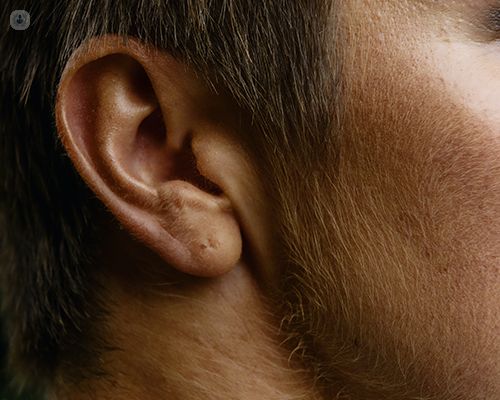Post-operative recommendations for middle ear and mastoid surgery: What can patients expect
Autore:Middle ear surgery is the term for various surgical procedures (including tympanoplasty and mastoidectomy) that treat problems or conditions which affect the tympanic membrane, the ossicles and the mastoid cells. Although individual responses can vary depending on the operation performed, following your ENT surgeon’s post-operative instructions is key to the success of the surgery and your healthy recovery.
Here, Mr Harry Powell, leading consultant ENT surgeon, provides an expert post-operative care guide for middle ear surgery, explaining what patients can expect after surgery and what can and cannot be done.

What happens during middle ear surgery?
In middle ear surgery, the anaesthetic team is responsible for caring for the patient’s wellbeing. Generally, this involves placing a tube through the patient’s mouth so that a specialist machine can breathe for the patient while he/she is asleep (under anaesthesia). Due to the breathing tube, patients may have a sore throat for a couple of days after the procedure.
In some operations, tiny needles are placed under the skin near the patient’s eyebrows and the corner of the mouth or the top lip. These needles, connected to a specialist machine to monitor the patient’s facial nerve, are usually removed at the end of the surgery. Despite their removal, patients may occasionally develop bruising after the procedure, which will take a week or more to heal.
Will patients feel any pain?
The ear may feel sore for seven to 14 days after surgery. For the duration of that period, patients are recommended to take regular simple painkillers such as paracetamol and ibuprofen to relieve this tenderness, as necessary.
What can patients expect after the procedure?
Following surgery, patients may go home or stay overnight at the hospital, depending on how well they feel and whether the operation finishes earlier or later in the day. If it is later, the possibility of staying overnight is higher.
Patients may feel numbness in the top part of the ear, but this will disappear approximately three months after the surgery. In addition, patients may also develop bruising that runs down the neck from behind the ear – although this is more common in older patients. This bruising will settle after two to three weeks.
In some cases, patients may wake up from the anaesthesia with a bandage on their head, wrapped to protect the operated ear during the first hours (or the first night) after the procedure. The bandage will be removed the following morning, either before the patient is discharged or when the patient is in their home.
Above all, to reduce the possibility of an infection, it is essential that the ear remains dry after surgery. Although a dry shampoo can be used, patients must not wash their hair for at least 10 days following surgical intervention. When bathing or showering, the ear canal can be protected with a cotton wool covered with Vaseline, which helps to repel water. A shower cap is also useful.
The incision:
If an incision was performed during surgery, white sticky dressings may be placed over it. These dressings should remain in place for seven to 10 days, after which they can be peeled off. There is no need to worry if the sticky dressings come off sooner, but patients should wait five to 10 days before attempting to clean or wash the incision.
I will often use stitches that are absorbable and thus, they may not be seen beneath the skin. On occasion, I will use blue stitches and these will have to be removed eight to 10 days after the operation, by the nurse at the patient’s GP surgery. Detailed instructions will be included in the patient’s discharge letter, if this is the case.
The ear canal:
While it heals, the ear will be protected by dressings that fill the ear canal. These dressings will be removed when the patient returns to the clinic, but until then, they may cause the ear canal to feel blocked.
Besides blockage, there may also be a bit of bloody discharge from the ear for the first few days after surgery. For this reason, patients are free to change any outer cotton wool as required, which may be three to four times a day at the beginning and then decrease in frequency as time passes.
If infection or inflammation was found, patients may be prescribed oral antibiotics for five to seven days following surgery. It is important for patients to take this medication as prescribed.
Possible symptoms:
Many ear surgeries require the ear drum to be lifted, operating near to or around the taste nerve. If there is disease or (in some occasions) if it is needed for surgical access, the taste nerve will sometimes be bruised or damaged, leading to a metallic taste in the mouth on the tongue on the side of the surgery. The damage to the taste never will improve in the six to 12 weeks after the procedure.
For a short period, balance may also be affected after surgery. Some patients may suddenly be very dizzy and feel sick, and this can partly be a reaction to the anaesthetic drugs and partly a result to the disturbance of the inner ear. This will usually settle within the first days after surgery and patients are recommended to take one or two weeks off work to get plenty of rest during those days. Patients will feel better and have strength to do more as their recovery progresses, so they should not overexert themselves.
Right after the operation, patients with tinnitus (a condition characterised by ringing or roaring sounds in the ear) may experiment a downturn. Due to the disturbance of the inner ear and/or the blockage of the middle or outer ear, tinnitus may even occur in patients with no previous history or symptoms of tinnitus. This will resolve itself as the ear heals.
Besides this, patients should also:
- Know that they will hear popping and crackling sounds as the ear heals
- Avoid straining and lifting heavy load
- Avoid stifling their sneezes
- Be very gentle if they blow their nose
- Know that they may get a pulsing sensation
- Avoid arranging air travel four to six weeks following surgery (if in doubt, patients should always check with their ENT surgeon)
- Avoid scuba diving or air travelling with a cold (if possible), but this depends on the operation performed
- Avoid driving if they feel dizzy or off-balance
When will the follow-up appointment take place?
The post-operative clinic appointment will take place one to six weeks after the surgery, depending on how long the ear canal dressing is recommended to remain in place. I sometimes use absorbable ear canal dressings and these will require patients to put in ear drops before returning to the clinic.
An urgent review will be arranged immediately if any complications develop during a patient’s recovery, including aggravated imbalance or dizziness, very strong tinnitus or severe pain after steadily improvement.
If you are considering middle ear and mastoid surgery and wish to discuss your surgical options and post-operative care with an expert ENT surgeon, don’t hesitate to visit Mr Powell’s Top Doctors profile today.


